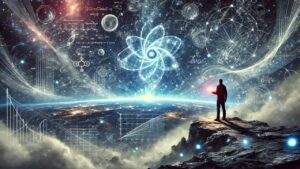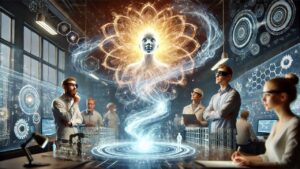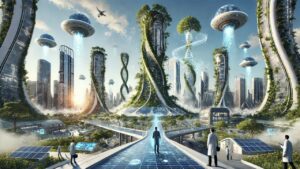Thought Experiment: What If Engineers Are Co-Creators?
What If Engineers Are Co-Creators? A Thought Experiment on Ethical Innovation
Introduction: What If Engineering Is a Form of Stewardship?
Imagine that every law of physics, thermodynamics, and electromagnetism was placed in the universe, not by chance, but as part of a structured, pre-existing order waiting to be discovered. Now, consider this given the dramatic change we experienced during and after the COVID lockdown: as engineers, are we merely problem solvers, or are we stewards, entrusted with uncovering and applying these laws responsibly?
Before dismissing this as an abstract question, think about what it really means. Every scientific breakthrough has been the result of uncovering deeper truths about the universe. The structure of DNA, the behavior of electromagnetic waves, and even the principles governing artificial intelligence were all there before we found them.
If this is true, then engineering is not just an intellectual exercise—it is a form of stewardship, where responsibility matters as much as discovery. The question is: are we handling this responsibility wisely?
What If Artificial Intelligence Isn’t the Problem—But How We Use It Is?
Many people today see Artificial Intelligence (AI) as a threat—a force that diminishes human dignity, replaces jobs, and even challenges moral agency. And in some cases, this fear is justified. AI, when wielded without ethical constraints, can be a tool of surveillance, manipulation, and deception.
But is AI itself inherently bad? Or is it, like any powerful technology, a tool that depends on the moral compass of its creators?
Consider historical parallels:
- The printing press: Once feared as a tool that would spread misinformation, it became a vehicle for global knowledge-sharing.
- Radio and television: Initially seen as distractions, yet they transformed education, communication, and emergency response.
- The internet: A place of misinformation, but also a means to connect, educate, and drive innovation on an unprecedented scale.
If AI, like these technologies, can be misused, should our response be to reject it outright—or to ensure that it is guided by ethical principles?
What If We Are at an Ethical Crossroads?
AI is not inherently moral or immoral—it reflects the intentions of its creators. This presents us with two possible futures:
Ethical Stewardship: AI designed for truth, justice, and human flourishing—enhancing medicine, education, and ethical governance.
Unchecked Innovation: AI that deceives, controls, and replaces human dignity—deepfakes, manipulation, and surveillance.
Which world do we want to create?
What If Engineers Led with Virtue?
The legendary coach John Wooden built his Pyramid of Success around values like integrity, wisdom, and servant leadership—values deeply aligned with strong, principled decision-making. Imagine applying these principles to engineering leadership:
- Integrity & Stewardship: AI should serve humanity, not replace it.
- Wisdom & Prudence: We must question AI’s implications before blindly adopting it.
- Justice & Responsibility: AI must promote human dignity, not commodify people.
This is why many leading ethicists and organizations have called for a human-centered approach to technology—one that ensures tools like AI serve the common good rather than diminish it.
What If Engineers Are the Last Line of Defense?
If AI will shape the future, who will shape AI?
IEEE, as the world’s largest technical professional organization, has the responsibility to ensure that engineers drive ethical innovation rather than succumb to short-term incentives. This requires:
✅ Mentorship & Ethical Leadership – Teaching the next generation of engineers to wield AI responsibly.
✅ Setting Standards for Ethical AI – Ensuring that technology aligns with principles of truth, transparency, and dignity.
✅ Advocating for AI That Preserves Free Will – Rejecting AI that manipulates or suppresses human autonomy.
This is not just about technology—it is about defending the dignity of the individual and the integrity of society.
What If This Choice Is Ours?
So, let’s return to the original question: What if engineers are co-creators of the future?
What if AI, rather than being an inherent evil, is simply another test—a tool that can be used for good or for harm, depending on who wields it?
What if your role as an engineer is not just to build the future, but to ensure that it aligns with the principles of virtue, truth, and justice?
If that’s true, then the real question isn’t What can we do?—it’s What should we do?
The choice is ours.
Some Visuals and Their Description
Engineer as a Co-Creator
This image portrays a futuristic engineer standing at the edge of a vast cosmic landscape, symbolizing the exploration of universal truths through science and technology. The glowing blueprint of the universe represents the laws of physics, mathematics, and nature’s intricate design, blending seamlessly with waterfalls, stars, and forests. This integration highlights the engineer’s role in harmonizing human innovation with the natural world rather than opposing it.
The engineer’s glowing tool signifies human agency in shaping the future. Rather than being mere discoverers, engineers play a role in applying and extending these universal principles, much like an artist working within a predefined canvas of natural laws. The attire—a mix of modern and timeless design—suggests a continuity of knowledge, linking past, present, and future thinkers.
This scene embodies awe, discovery, and responsibility, encouraging engineers to view themselves as stewards of knowledge who must balance progress with ethical considerations.
Ethical AI as a Collaborative Force
This image presents an ethereal, energy-based artificial intelligence—a radiant, glowing entity floating over an advanced research lab. Unlike the typical humanoid or mechanical AI representations, this AI is depicted as a swirling vortex of knowledge, symbolizing pure computation, wisdom, and limitless data processing.
The tendrils of light extending from the AI are interacting with a team of engineers, who are collaboratively designing futuristic technology. This interaction highlights the potential for AI to be a tool that augments human capabilities rather than replaces them. The engineers, equipped with advanced augmented reality glasses, are seen deep in discussion, their holographic designs mirroring the AI’s radiance. This suggests a symbiotic relationship where humans remain in control, guiding AI toward ethical applications.
This scene encapsulates the wonder of technological creation while also raising ethical considerations. The AI’s non-threatening form contrasts the common fear of AI as an autonomous force, instead presenting it as a potential co-creator—an extension of human intellect and ethical responsibility.
A Grand Futuristic Cityscape Powered by Sustainable Energy
This image envisions a future where human ingenuity and environmental responsibility exist in perfect harmony. It showcases a city of the future, where sustainability is not an afterthought but the very foundation of civilization. The towering skyscrapers are designed with organic, flowing architecture, seamlessly integrating greenery to enhance biodiversity and air purification.
Engineers and scientists are seen walking along floating pathways, symbolizing the integration of advanced infrastructure that reduces urban congestion and preserves natural landscapes. Holographic interfaces float around them, displaying real-time data on renewable energy usage, smart grid connectivity, and environmental impact assessments.
Above the city, massive clean-energy airships hover, representing a new age of transportation that relies on zero-emission energy sources. These airships signify that the world has moved beyond fossil fuels, embracing technology that supports ecological balance.
This image serves as an inspiring vision of what is possible when ethical engineering, sustainable design, and technological progress align. It asks a fundamental question: Are we engineering for short-term convenience, or are we building a future that respects both innovation and the natural world?




